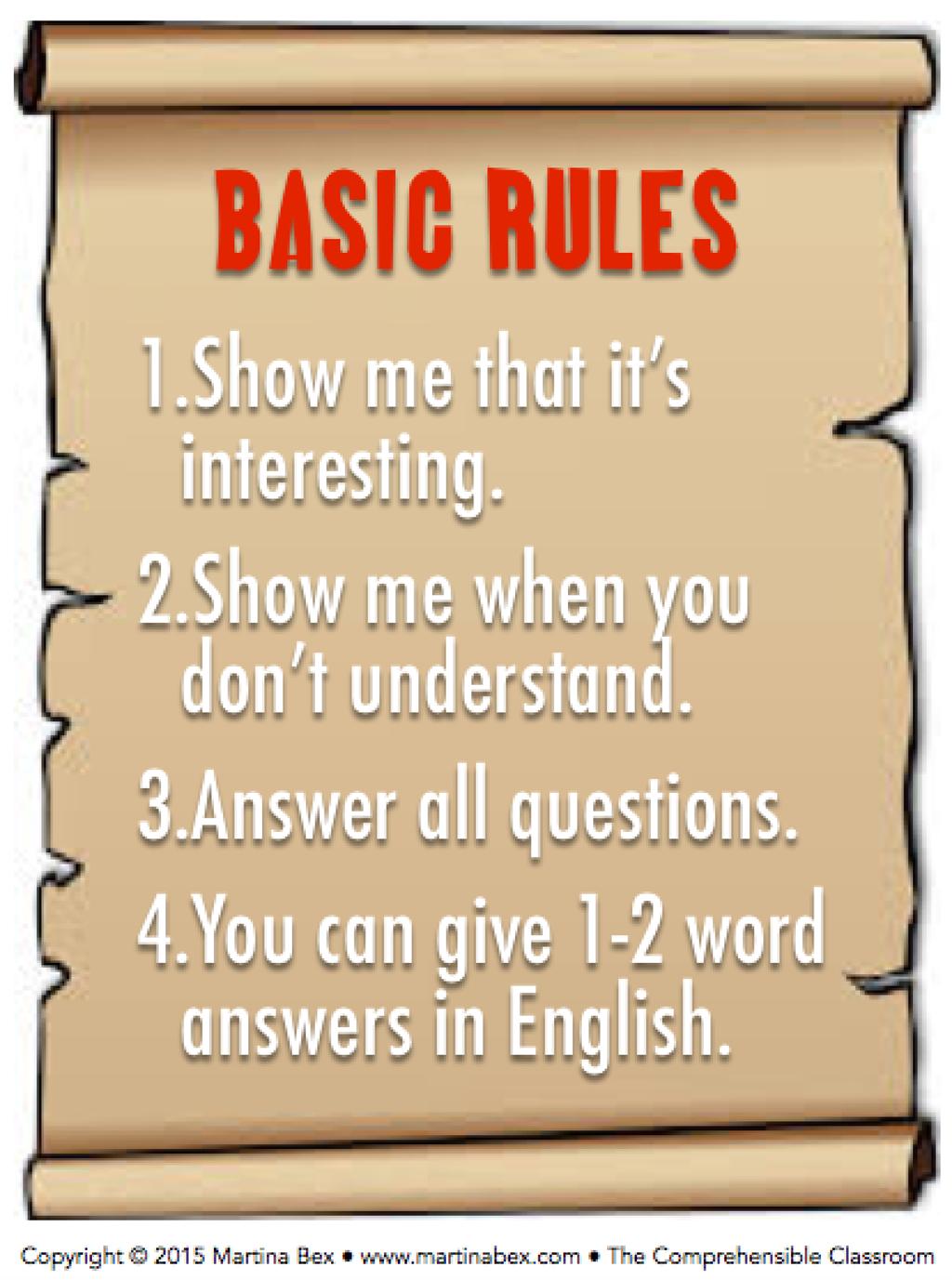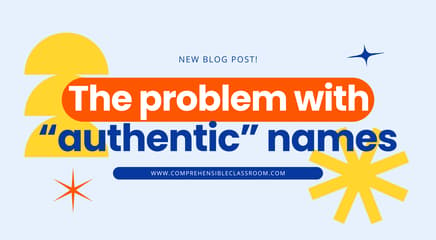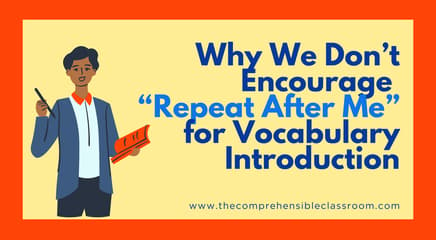This is the sixth post in the series "TPRS® 101: Teaching Proficiency is Really Simple".

The first week back from winter break is like a re-start for many teachers. You set goals back in August, and you’ve accomplished some but fell short of others. You spent a semester learning and growing as a professional, and you have an arsenal of new ideas to implement and with which to experiment before the end of the year.
This is the perfect week to give TPRS® a try for the first time! You’re (hopefully) feeling refreshed both mentally and physically and your students have lots to talk about coming off the break.
To first time TPRS®ers, I don’t recommend tackling a full-on story (although many of us have taken that approach and somehow survived!). I recommend developing your skills and easing students into the process through Card Talk (learn more about it here!) which is basically a strategic teacher-led class discussion. You’ll want to do a little homework before your first attempt (read Steps 1-5 in the TPRS® 101 series starting here), and here is what to do when the big day arrives:
FIRST, ESTABLISH MEANING
If applicable, introduce any new Core Vocabulary structures to students. Write them on the board with a black marker (target language) and a blue marker (English). Say the structure in the target language and say what it means in English. In the target language, tell students to NOT repeat you as you say it! Force them to have a silent period and simply listen to you say the target structure several times in the target language (read more about why in this post). As you repeat the target structure several times, show students a gesture and have them mimic you. Again, they are listening (not speaking) and gesturing: that’s it. Say and gesture the target structure again and then, while pointing to the English translation, ask a student in the class, in English, “What does [target structure] mean in English?”. This seems like a way-too-obvious comprehension check, but it is absolutely essential that you establish the meaning of the target structure accurately at the beginning of the activity. (Usually, I go through some more steps when introducing target structures, but since you are just dipping your toes in the pool of TPRS®, I wouldn’t tackle them today.) If you are not using a new structure in this discussion, you can skip this step.
SECOND, ASK THE QUESTION
Ask the question that you have planned to discuss in the target language. Say it slowly and check for comprehension. Make sure that students understand the question! If you are reading the Step 5 post at the end of winter break and planning for your first day(s) back, some great questions to choose from are
- Where did you go last week/during vacation/etc?
- What did you do during vacation?
- Who did you see during vacation?
- What did you get for Christmas? (If you use this question, just be sensitive to students in your class that don’t celebrate Christmas or might not have received anything for Christmas that they want to discuss with the class.)
- What did you NOT do that you wanted to do over break?
THIRD, GIVE STUDENTS TIME TO RESPOND
Also optional (but recommended), have students illustrate their answer to the question. I think that it is extremely helpful to you, as the teacher, to have some sort of a prop to use during this discussion. All of the above questions allow students to easily illustrate their responses.
FOURTH, EXPLAIN THE PURPOSE
If you are teaching students a new structure, establish the purpose of the discussion: “Now, we are going to talk about [what you didn’t do that you wanted to do over break]. The goal of this conversation is to have a fun talking about break AND to get comfortable hearing and using “[new structure]”. In order for that to happen, you need to hear [new structure] many, many times in a context that you understand. So we are going to be discussing [what you didn’t do that you wanted to do over break], and over the course of the conversation you are going to hear and understand me say “[wanted to do]” many, many times, and this is going to help you acquire it, or get comfortable hearing and using it. If you are not using a new structure in this discussion, you can skip this step.
FIFTH, LAY OUT THE RULES
Lay out the ground rules IN ENGLISH. Yes, in English. It is absolutely imperative that students ‘play by the rules’ in TPRS®. Explaining the instructions in English will only take you a few moments, and it will ensure that all students (well, assuming they speak English!) completely understand what their role is in the coming activity. But what rules to share? There are many excellent suggested lists, and truly there is not much variance between teachers that use TPRS®. I stole my first list of rules for story asking from Ben Slavic, and his website is a good place to start. For the purposes of this activity and to not overwhelm your students, I’d only give a few today. Introduce them by saying something like, There are a few important rules for this conversation:

- Everything new thing that I say—every new piece of information that I give you—is the most interesting thing that you have ever heard. Since you think that everything that I say is so interesting, you can’t contain your excitement! Every time that I say a new piece of information, you need to say, “Oooooh!” (or “Aaaah!” or “Wow!” or…). Let’s practice. “Guys, My name is [Mrs. Bex]!” Wait for students to react like you just showed them, then shower the first student that responds with an “Ooooh!” with praise. Since the first response will probably not be amazing, say, “Oh no no no no. That won’t work at all. You need to convince me that you think I am interesting! Let’s try again: “Guys, my name is [Mrs. Bex]!” Wait for a response…hopefully it’s better this time. Continue to prod students until you get a response with which you are satisfied, then give students a few more “interesting” pieces of new information: I am a [Spanish] teacher! Signal/wait for response, then congratulate.I live in [Alaska]! Signal/wait for response, then congratulate.
- Okay, next rule: it is absolutely essential that you understand everything that I say, all the time. If you do not understand something that I say, you need to let me know. The way that you let me know is (describe a signal that you want them to use: some common ones are ‘zooming’ your hand past your head and saying “zoom”, implying that it’s over their head, or pounding the fist of one hand into the palm of the other several times). Let’s practice! Say something in the target language that students do NOT understand or something in a different language. When the first student does the ‘I don’t understand’ signal, run to them, give them a big high five, and shower them in praise: “Awesome! Wow! That was amazing! I love how you showed me that you didn’t understand! That was excellent!” Do this several times until all students seem to be signaling QUICKLY that they don’t understand what you’ve just said. Linda Li does such a great job with this!!
- You MUST answer my questions. Whether it is a yes/no, either/or, or open-ended question, I need to hear your response. I’m going to be asking some questions to make sure that you understand me, so if I ask a question about something that I’ve already said, you have to answer truthfully. If I ask for new information, though, feel free to lie. You can tell the truth or you can tell me something that is more interesting than the truth. For example, if I say, “Why did Jenny want to go to the gas station?” and Jenny hasn’t already told us the answer, then you can make up anything that you want as long as it is appropriate. You could say, “She needed to buy gas” or you could say, “She was planning to rob it”. In order to keep this conversation interesting, it might be necessary to embellish the truth a bit…or ignore it altogether!
- If you have an answer but you don’t know how to say it in the target language, you can say one or two words in English and I will translate it for you if needed. Otherwise, answer my questions in the target language!
SIXTH, LEAD THE CONVERSATION
Okay, time to dive in! Walk around the room until you see an interesting illustration. Make sure that it is from a student that won’t mind you talking about them. Grab the illustration and examine it! Then, hold it so that the class can see it, and start walking slowly around the room, moving back toward the board, while students look at it. In the target language, say, “Class, [what did Jenny want to do… point to the translation of the new structure that you’ve written on the board and pause for a moment …during break but didn’t]?”. Students will probably not volunteer an answer right away, so start giving options to model what you want. “Did Jenny want to… point to the translation of the new structure ‘wanted to’ on the board and pause for a moment…eat pizza during break?” Wait for a response from students, then praise them when they respond! No! Jenny did not want to… point to the translation of the new structure ‘wanted to’ on the board and pause for a moment… eat pizza during break. Did Jenny want to … point to the translation of the new structure ‘wanted to’ on the board and pause for a moment…go to California during break? Wait for a response from students, then praise them when they respond! No! Jenny did not want to…go to California during break. What did Jenny want to … do?” Wait for an interesting response. Any time that students give you an answer, reflect it back to the class, then either affirm or discard it with a “Yes! Jenny wanted to…” or “No, Jenny did not want to…”. For more on this questioning strategy, please read this post about circling. Once you have a good answer that you want to work with, say “Yes! Jenny wanted to… point and pause…go on a date with Juanes. Circle the statement with yes/no, either/or questions, and who/what questions, then ask for new information: Why did Jenny want…point and pause… to go on a date with Juanes? Continue to discuss Jenny’s illustration, getting more and more details. If using this question, remember to also talk about why she didn’t do what she wanted to do, since that was the second part of the prompt. Above all, you must keep the discussion comprehensible! Use proper nouns and cognates as often as possible (write down cognates for students on the board so that they can SEE the similarity), and only use target language words that the students don’t understand if you absolutely must and if you write them down the target language and English translation on the board. You are setting the stage for all future TPRS® lessons right now, and a first impression of feeling confused and overwhelmed will seriously undermine your future lessons.
- At some point, the conversation about “Jenny” needs to end. But how do you know when to wrap up discussion about one student’s picture and move on to a new one? Keep the conversation going as long as students remain interested. If you share an illustration and don’t get any interesting details from the first couple of questions that you ask, then end it. It’s okay to talk about different students for different amounts of time. Always honor the student that you are discussing by reacting to their answer in some way, like “Wow! I want to go there too!, or “Wow, you wanted to go sky diving?! You are so brave!”. Once you have honored their answer, you can grab a new paper and move the conversation on to a new subject. When you have an interesting discussion going, then stick with it, asking for more details and follow-up questions until interest wanes. You will know that a conversation is interesting when students are looking at you, answering your questions, signaling when they don’t understand, etc. (following the rules), and reacting in natural ways: laughing, gasping, etc.
SEVENTH, KEEP GOING 'TIL YOU'RE DONE OR THEY'RE DONE
Keep grabbing and discussing new papers until class ends OR you and/or the students are just done. How do you know when to bail?
- If students appear to be disinterested, it could be because (1) the conversation is not interesting and it’s time to move on to a new illustration/subject, (2) students don’t understand, (3) students need a brain break. Be sure to check for comprehension frequently and in varied ways so that you guarantee that (2) is not the cause of apparent disinterest. If the conversation is interesting and students understand, then try a brain break. Here are my favorites!
- If students are disinterested or you are overwhelmed, BAIL. Remember, this is only your first attempt! It is highly unlikely that your first lesson will look like a TPRS® demo that you would see by an expert trainer at a TPRS® workshop or conference. One thing that I like about using illustrations is that they give you a way to bail gracefully: instead of ending the activity abruptly and moving on to completely unrelated content, you can use them to smooth the transition and make it seem like you had planned it that way all along. Here are three non-CI activities that you can do with the illustrations that will allow you to catch your breath and live to CI another day.
- Have students write out a description of their own illustration on the back of the paper, then have the class do simultaneous presentations to share them with classmates.
- Have students write one sentence about their own illustration, then pass it to the next student to add another descriptive sentence about it. Continue passing papers until each one has 5-6 sentences. You can use these descriptions to try another CI discussion once you’ve recovered from the emotional overload of your first lesson!
- Have students write one sentence to describe their picture in the top frame of a Write, Draw, Pass form, then play Write, Draw, Pass. (If you don’t have forms copied ahead of time, students can always do this with a blank piece of paper…I always keep a set of copies on hand for desperate times like this!)
Dude, you've totally got this.




